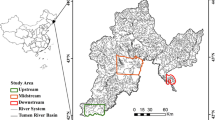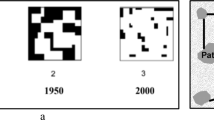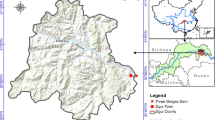Abstract
The quantitative research of wetland landscape fragmentation in the middle reaches of the Heihe River is important for the wetland and oasis sustainable development in the Hexi Corridor. Based on the data of remote sensing and GIS, we constructed the type change tracker model with sliding window technique and spatially morphological rule. The suitable scale and optimum scale of the fragmentation model of wetland landscape in the middle reaches of the Heihe River were determined by the area frequency statistics method, Chi-square distribution normalized scale variance, fractal dimension and diversity index. By integrating type change tracker model and the optimum scale with GIS spatial analysis, the spatial distribution characteristics of wetland landscape fragmentation in different periods and the related spatial-temporal change process were clarified. The results showed that (1) the type change tracker model, which analyzes the spatial pattern of wetland fragmentation on the pixel level, is better than the traditional wetland fragmentation analysis on the landscape and patch levels; (2) The suitable scale for the wetland fragmentation ranged from 150 m×150 m to 450 m×450 m and the optimum scale was 250 m×250 m in the middle reaches of the Heihe River; and (3) In the past 35 years, the total wetland area decreased by 23.2% and the fragmentation of wetland markedly increased in the middle reaches of the Heihe River. The areas of core wetlands reduced by 12.8% and the areas of perforated, edge and patch wetlands increased by 0.8%, 3.1% and 8.9%, respectively. The process of wetland fragmentation in the research region showed the order of core wetland, perforated or edge wetland, patch wetland or non-wetland. The results of this study would provide a reference for the protection, utilization and restoration of limited wetland resources and for the sustainable development of the regional eco-environment in the Heihe River Basin.
Similar content being viewed by others
References
Chen Y, Zhang D Q, Sun Y B, et al. 2005. Water demand management: a case study of the Heihe River Basin in China. Physics and Chemistry of the Earth, Parts A/B/C, 30(6): 408–419.
Civco D L, Hurd J D, Wilson E H, et al. 2002. Quantifying and describing urbanizing landscapes in the northeast United States. Pho togrammetric Engineering and Remote Sensing, 68(10): 1083–1090.
Costanza R, d’Arge R, de Groot R, et al. 1997. The value of the world’s ecosystem services and natural capital. Nature, 387: 253–259.
Deimeke E, Cohen M J, Reiss K C. 2013. Temporal stability of vegetation indicators of wetland condition. Ecological Indicators, 34: 69–75.
Desta H, Lemma B, Fetene A. 2012. Aspects of climate change and its associated impacts on wetland ecosystem functions-a review. Journal of American Science, 8(10): 582–596.
Fang C L, Bao C, Huang J C. 2007. Management implications to water resources constraint force on socio-economic system in rapid urbanization: a case study of the Hexi Corridor, NW China. Water Resources Management, 21(9): 1613–1633.
Fleiss J L, Levin B, Paik M C. 2003. Statistical Methods for Rates and Proportions (3rd ed). New Jersey: John Wiley & Sons, 598–626.
Gibbes C, Southworth J, Keys E. 2009. Wetland conservation: change and fragmentation in Trinidad’s protected areas. Geoforum, 40(1): 91–104.
Herold M, Scepan J, Clarke K C. 2002. The use of remote sensing and landscape metrics to describe structures and changes in urban land uses. Environment and Planning A, 34(8): 1443–1458.
Jenkins G A, Greenway M, Polson C. 2012. The impact of water reuse on the hydrology and ecology of a constructed stormwater wetland and its catchment. Ecological Engineering, 47: 308–315.
Jiang P H, Zhao R F, Zhao H L, et al. 2013. Relationships of wetland landscape fragmentation with climate change in middle reaches of Heihe River, China. Chinese Journal of Applied Ecology, 24(6): 1661–1668. (in Chinese)
Lasanta T, Vicente-Serrano S M. 2012. Complex land cover change processes in semiarid Mediterranean regions: an approach using landsat images in northeast Spain. Remote Sensing of Environment, 124: 1–14.
Lee P, Smyth C, Boutin S. 2004. Quantitative review of riparian buffer width guidelines from Canada and the United States. Journal of Environmental Management, 70(2): 165–180.
Li M S, Zhu Z, Vogelmann J E, et al. 2011. Characterizing fragmentation of the collective forests in southern China from multitemporal Landsat imagery: a case study from Kecheng district of Zhejiang province. Applied Geography, 31(3): 1026–1035.
Li S B, Zhao W Z. 2010. Landscape pattern changes of desert oasis wetlands in the middle reach of the Heihe River, China. Arid Land Research and Management, 24(3): 253–262.
Martínez-López J, Carreño M F, Martínez-Fernández J, et al. 2014. Wetland and landscape indices for assessing the condition of semiarid Mediterranean saline wetlands under agricultural hydrological pressures. Ecological Indicators, 36: 400–408.
Mereta S T, Boets P, Ambelu Bayih A, et al. 2012. Analysis of environmental factors determining the abundance and diversity of macroinvertebrate taxa in natural wetlands of Southwest Ethiopia. Ecological Informatics, 7(1): 52–61.
Miller S J, Wardrop D H. 2006. Adapting the floristic quality assessment index to indicate anthropogenic disturbance in central Pennsylvania wetlands. Ecological Indicators, 6(2): 313–326.
Mitsch W J, Bernal B, Nahlik A M, et al. 2013. Wetlands, carbon, and climate change. Landscape Ecology, 28(4): 583–597.
Moellering H, Tobler W. 1972. Geographical variances. Geographical Analysis, 4(1): 34–50.
Montgomery D R, Dietrich W E. 1992. Channel initiation and the problem of landscape scale. Science, 255(5046): 826–830.
Nabahungu N L, Visser S M. 2011. Contribution of wetland agriculture to farmers’ livelihood in Rwanda. Ecological Economics, 71: 4–12.
Nielsen E M, Prince S D, Koeln G T. 2008. Wetland change mapping for the US mid-Atlantic region using an outlier detection technique. Remote Sensing of Environment, 112(11): 4061–4074.
Niemi G J, McDonald M E. 2004. Application of ecological indicators. Annual Review of Ecology, Evolution, and Systematics, 35: 89–111.
Niu Z G, Zhang H Y, Wang X W, et al. 2012. Mapping wetland changes in China between 1978 and 2008. Chinese Science Bulletin, 57(22): 2813–2823.
Riitters K H, Wickham J D, O’Neill R V, et al. 2000. Global-scale patterns of forest fragmentation. Conservation Ecology, 4(2): 3.
Riitters K H, Wickham J D, O’Neill R V, et al. 2002. Fragmentation of continental United States forests. Ecosystems, 5(8): 815–822.
Shalaby A, Tateishi R. 2007. Remote sensing and GIS for mapping and monitoring land cover and land-use changes in the Northwestern coastal zone of Egypt. Applied Geography, 27(1): 28–41.
Shen Z, Xie S Q, Pan C Y. 2008. Probabilities and Statistics. Beijing: Higher Education Press, 135–147. (in Chinese)
Song C C, Wang L L, Guo Y D, et al. 2011. Impacts of natural wetland degradation on dissolved carbon dynamics in the Sanjiang Plain, Northeastern China. Journal of Hydrology, 398(1): 26–32.
Teferi E, Uhlenbrook S, Bewket W, et al. 2010. The use of remote sensing to quantify wetland loss in the Choke Mountain range, Upper Blue Nile basin, Ethiopia. Hydrology and Earth System Sciences Discussions, 7(4): 6243–6284.
Townshend J R G, Justice C O. 1990. The spatial variation of vegetation changes at very coarse scales. International Journal of Remote Sensing, 11(1): 149–157.
van Roon M R. 2012. Wetlands in The Netherlands and New Zealand: optimizing biodiversity and carbon sequestration during urbanization. Journal of Environmental Management, 101: 143–150.
Verones F, Saner D, Pfister S, et al. 2013. Effects of consumptive water use on biodiversity in wetlands of international importance. Environmental Science & Technology, 47(21): 12248–12257.
Vogt P, Riitters K, Estreguil C, et al. 2007. Mapping spatial patterns with morphological image processing. Landscape Ecology, 22(2): 171–177.
Vorpahl P, Moenickes S, Richter O. 2009. Modelling of spatio-temporal population dynamics of earthworms under wetland conditions-an integrated approach. Ecological Modelling, 220(24): 3647–3657.
Wade T G, Riitters K H, Wickham J D, et al. 2003. Distribution and causes of global forest fragmentation. Conservation Ecology, 7(2): 7.
Wang Z N, Huang N, Luo L, et al. 2011. Shrinkage and fragmentation of marshes in the West Songnen Plain, China, from 1954 to 2008 and its possible causes. International Journal of Applied Earth Observation and Geoinformation, 13(3): 477–486.
Wen Q K, Zhang Z X, Xu J Y, et al. 2011. Spatial and temporal change of wetlands in Bohai rim during 2000–2008: an analysis based on sat ellite images. Journal of Remote Sensing, 15(1): 183–200. (in Chinese)
Wilson E H, Sader S A. 2002. Detection of forest harvest type using multiple dates of Landsat TM imagery. Remote Sensing of Environment, 80(3): 385–396.
Wu J G, Shen W J, Sun W Z, et al. 2002. Empirical patterns of the effects of changing scale on landscape metrics. Landscape Ecology, 17(8): 761–782.
Yang M X, Nelson F E, Shiklomanov N I, et al. 2010. Permafrost degradation and its environmental effects on the Tibetan Plateau: A review of recent research. Earth-Science Reviews, 103(1): 31–44.
Young R G, Matthaei C D, Townsend C R. 2008. Organic matter breakdown and ecosystem metabolism: functional indicators for assessing river ecosystem health. Journal of the North American Benthological Society, 27(3): 605–625.
Yue T X, Liu J Y, Jøgensen S E, et al. 2003. Landscape change detection of the newly created wetland in Yellow River Delta. Ecological Modelling, 164(1): 21–31.
Zedler J B, Kercher S. 2005. Wetland resources: status, trends, ecosystem services, and restorability. Annual Review of Environment and Resources, 30: 39–74.
Zhang J, Zhou Y K, Li R Q, et al. 2010. Accuracy assessments and uncertainty analysis of spatially explicit modeling for land use/cover change and urbanization: A case in Beijing metropolitan area. Science China Earth Sciences, 53(2): 173–180. (in Chinese)
Zhang R Q, Zhai H Q, Tang C J, et al. 2009. Spatio-temporal location simulation of wetlands evolution of Yinchuan city based on Markov-CA model. WSEAS Transactions on Information Science and Applications, 6(7): 1145–1154.
Zhang Y R, Gong Z N, Gong H L, et al. 2011. Investigating the dynamics of wetland landscape pattern in Beijing from 1984 to 2008. Journal of Geographical Sciences, 21(5): 845–858.
Zhao C Y, Nan Z R, Cheng G D. 2005. Methods for estimating irrigation needs of spring wheat in the middle Heihe basin, China. Agricultural Water Management, 75(1): 54–70.
Zhao J, Chen X, Bao A M, et al. 2009. A method for choice of optimum scale on land use monitoring in Tarim River Basin. Journal of Geographical Sciences, 19(3): 340–350.
Zhao R F, Chen Y N, Zhou H R, et al. 2009. Assessment of wetland fragmentation in the Tarim River Basin, western China. Environmental Geology, 57(2): 455–464.
Zheng Q H, Luo G P, Zhu L, et al. 2010. Prediction of landscape patterns in Ili River Delta based on CA-Markov model. Chinese Journal of Applied Ecology, 21(4): 873–882. (in Chinese)
Zhou H R, Xiao D N, Zhou K F. 2006. Corridor effect of the spatial changes of landscape patterns in arid areas: a case study of the river corridor areas in the middle and lower reaches of Tarim River. Chinese Science Bulletin, 51(1): 82–91.
Zhu G F, Su Y H, Feng Q. 2008. The hydrochemical characteristics and evolution of groundwater and surface water in the Heihe River Basin, northwest China. Hydrogeology Journal, 16(1): 167–182.
Author information
Authors and Affiliations
Corresponding author
Rights and permissions
About this article
Cite this article
Zhao, R., Xie, Z., Zhang, L. et al. Assessment of wetland fragmentation in the middle reaches of the Heihe River by the type change tracker model. J. Arid Land 7, 177–188 (2015). https://doi.org/10.1007/s40333-014-0047-z
Received:
Revised:
Accepted:
Published:
Issue Date:
DOI: https://doi.org/10.1007/s40333-014-0047-z




